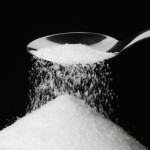I have a confession to make. On the rare occasions when I do use a sweetener, I actually use sugar or occasionally honey.
Now that doesn't happen very often; I don't have all that much of a "sweet tooth" and usually add a few Crasins to my unsweetened cereal in the morning and drink a non-coffee called Cafix (now that's a clever name; I suppose it's implying "Caffeine Fix") with a small amount of vanilla soy milk, but no sugar.
On Wednesday, January 4th of this year, The Wall Street Journal had a big spread in their "Personal Journal" section with an eye-catching title, Bracing for the Fake Sugar Rush." In the article four artificial sweeteners, Truvia, Splenda, Equal and Sweet"n Low' were compared to sugar. Prices were listed, tastes and aftertastes were compared, the sweetening agents were mentioned and the calories noted (0 for the articial sweeteners and 15 calories per teaspoon for the good old fashioned stuff).
Then I started thinking. I knew that adding 3,500 calories to my food intake theoretically would result in a weight gain of a pound. Since I enjoy math I wanted to figure out how much sugar that is. That translates into 233 and 1/3 teaspoons full or 1.167 kilograms of sugar (about two and a half pounds). So I'd have to eat two and a half pounds of sugar to, in theory, gain a pound of weight?
I went back to the article I just mentioned: my real reason for not using artificial sweeteners is two-fold. The WSJ admittedly "unscientific taste test" confirmed one of those; all four of the fake sugars had strange aftertastes according to their samplers: one was "Tab-like," one was compared to soap water, another termed metallic and the fourth said to leave a taste "like a copper pipe."
The other is safety; consumers often hear much later of concerns about new chemicals, whether they be sweeteners or medications. The managing director of a "brand-consulting firm" says one worry is "Did they test it on enough rats over a long enough period of time?"
Well, I've done basic lab research with rodents (three and a half years in medical school) and I'd really like to be able to say those experiments directly apply to humans, but I can't be sure that's a true statement. I did later work with dogs and when my boss (an associate professor at UCLA) was getting ready to present some of our results at an international conference, he came up with a great idea.
"Peter," he said, "when I show the slides with our data, someone in the back of the room is going to get up and ask if humans react the same way. So let's replicate our experiment in at least a few people."
Guess who was the first of those "people?" I was poked and prodded and infused with the same materials as our dogs.
In our case the data was essentially the same and when that inevitable heckler at the back of the room said his piece, my boss replied, "Let's have the first large slide."
But how much safety testing has been done with humans for these sweeteners? I'll try to find out if there are any long-term data on those of us who use non-caloric alternatives to sugar and write about that next.



